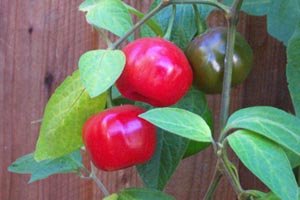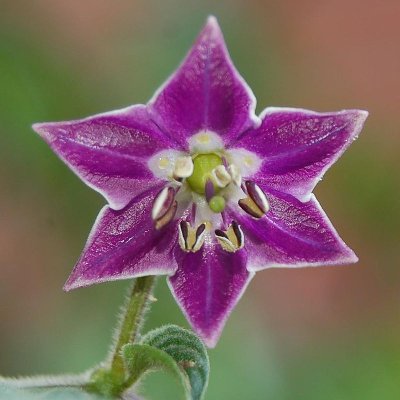Tree Pepper
 Common Names: Tree pepper, rocoto
Common Names: Tree pepper, rocoto
Scientific Name: Capsicum pubescens
Climate: Moderate and cold
Plant Description: It is a perennial shrub-type plant. It can grow to about four meters in height and two meters wide. Over time, it begins to look more like a woody plant. The leaves are five to twelve millimeters and oval, 2.5 to four cm wide. They are pointed at the top with a wider base. The flowers of the tree pepper are purple and violet with a little of white. The peppers are apple-shaped, yellow, red, or green in color. It can live for up to 15 years.
Cultivation: The tree pepper prefers partial shade. Irrigation must be regular, but it does not tolerate soggy soil, so it must be well-drained.
Seeds should be sown in late winter or early spring, preferably in a warm greenhouse, 40 to 50 centimeters apart. Germination takes approximately three to four weeks at 20 ° C. The first flowers appear 60 days after planting, taking another three months for fruit formation and ripening.
Harvesting should occur after 80-120 days when the fruits acquire the characteristic color, size and shape of the variety.
If you want to save the seed, they must be extracted directly from the fruit before the outer layer hardens. If not done in this way, the seeds can take a long time to germinate.
 Uses: It is excellent for use in fresh sauces, stews or fillings or pickles. Capsaicin is the component that produces the spiciness of the chili. It is used in the form of an ointment or cream to help with arthritis, rheumatism and muscle pain.
Uses: It is excellent for use in fresh sauces, stews or fillings or pickles. Capsaicin is the component that produces the spiciness of the chili. It is used in the form of an ointment or cream to help with arthritis, rheumatism and muscle pain.
Chili has anti-inflammatory, anti-irritant effects and helps to prevent pain. In addition, it has been found to be good for the heart due to its effect of lowering blood pressure, stimulating the circulatory system, and lowering cholesterol. Recently, chili has been considered for the development of anticancer treatments.
It has positive effects to decrease headache and migraine. It has high levels of vitamin C, which can help prevent respiratory diseases. Capsaicin stimulates the production of gastric juices, which improve digestion and cause more appetite.
Pests and Diseases: The fruits are usually resistant to insects. It is a plant that is prone to fungi, so excess moisture should be avoided. It is also recommended to cut the diseased parts of the plant with scissors disinfected with chlorine, and not to leave the residues near the plant. The waste should be burned.
Reference:
https://expansion.mx/salud/2011/09/15/el-chile-y-sus-efectos-beneficos-para-la-salud
En español: Chile cera
